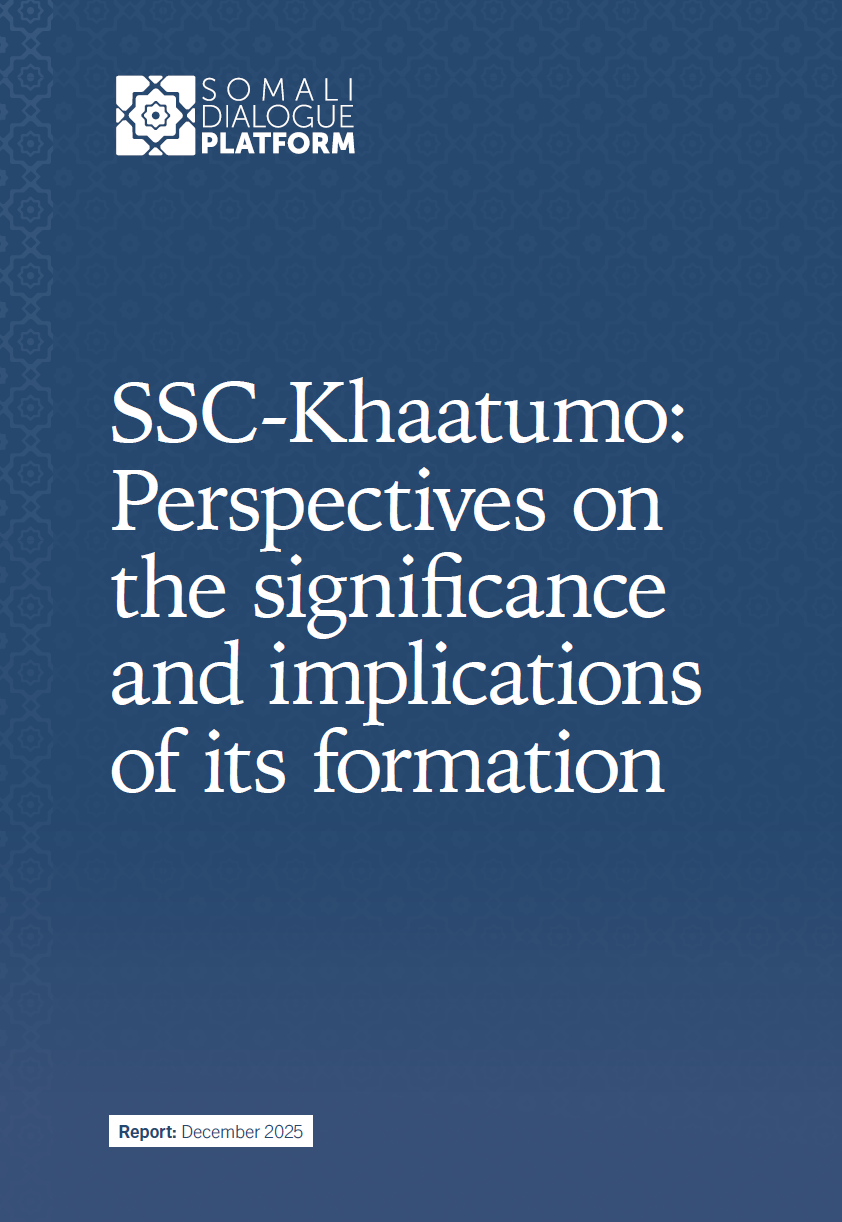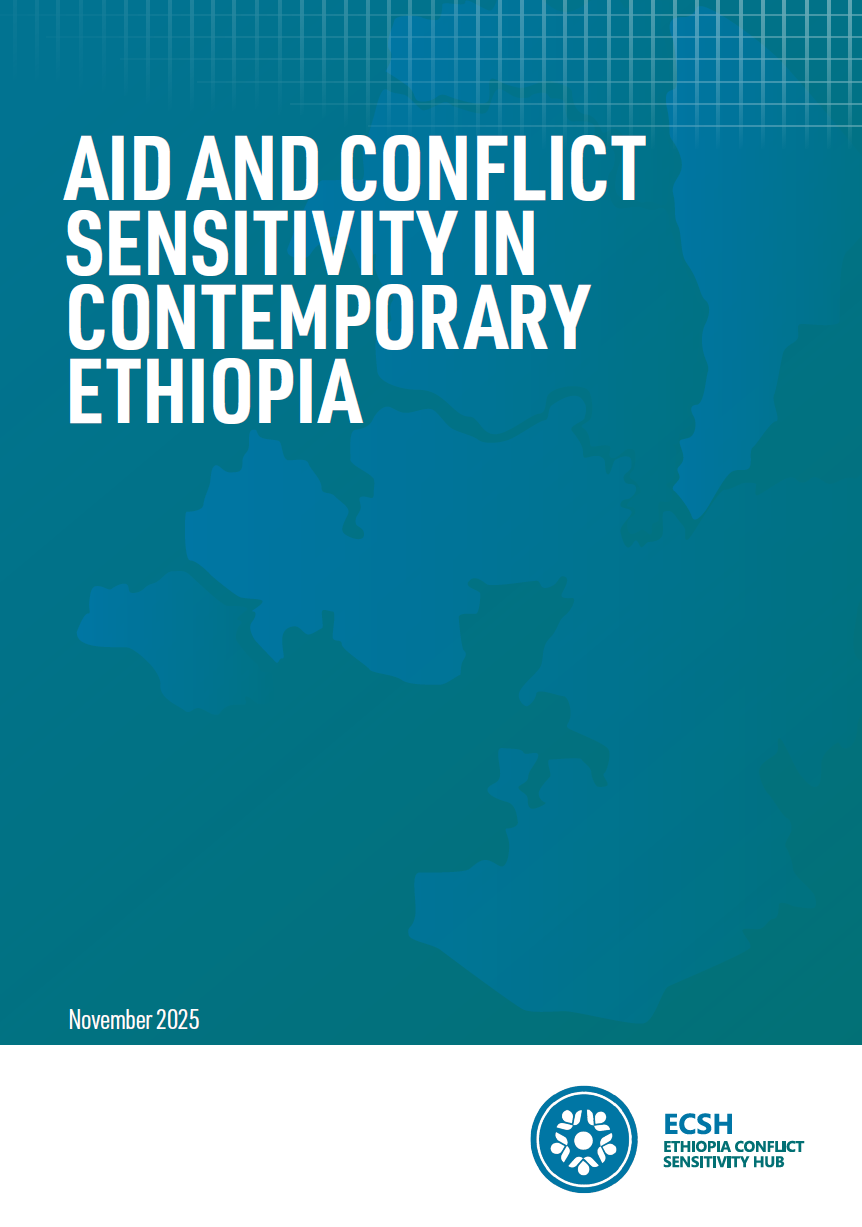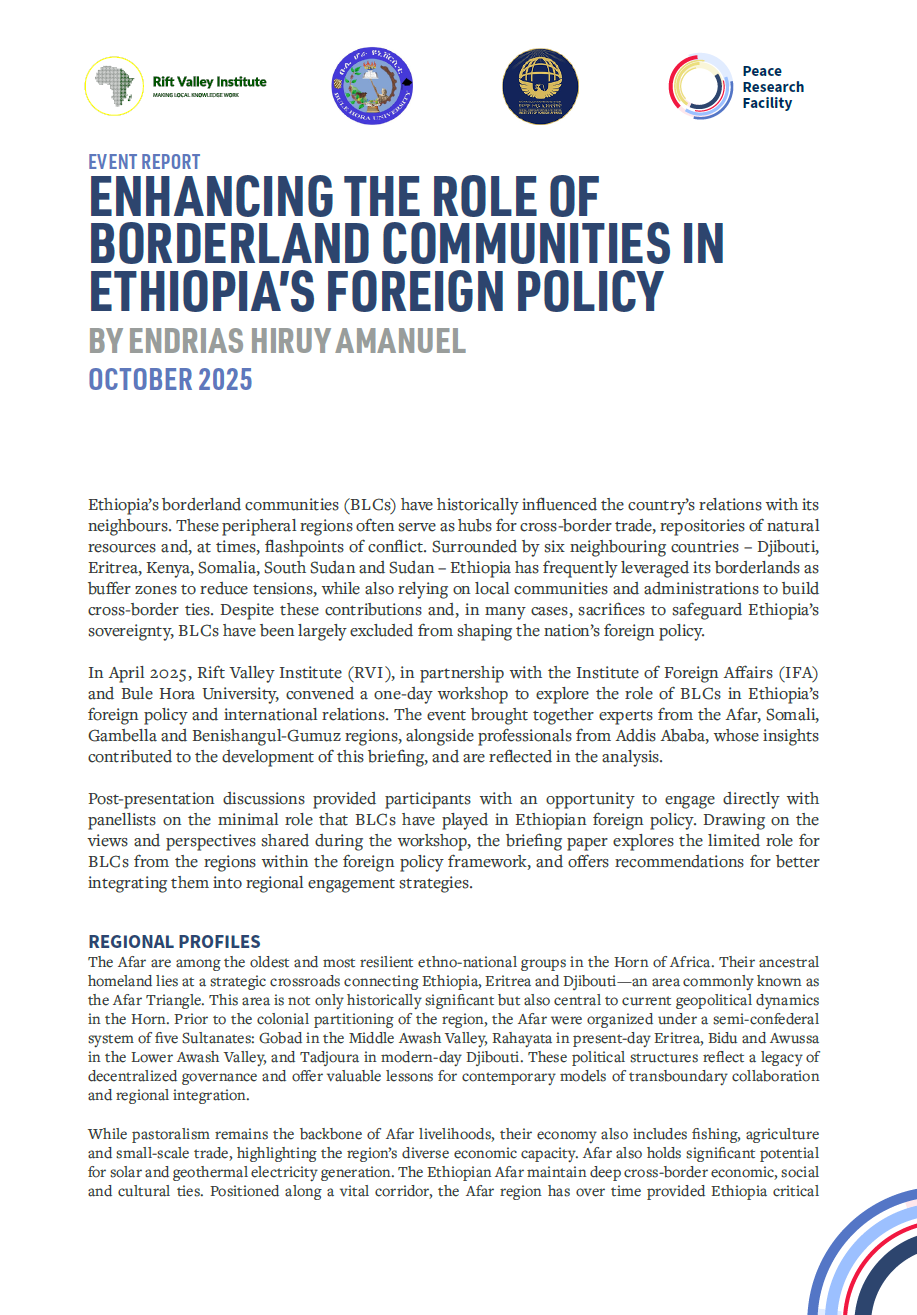Introduction
Prophecy among the Nuer of South Sudan is a living tradition. In recent conflicts prophets have played a part both in mobilization for war and in making peace. Historically, the most celebrated of the Nuer prophets was Ngundeng Bong, whose pronouncements—preserved in songs widely known in South Sudan—are thought by many to have foretold current events in the country. When Ngundeng’s son Guek was killed by the British in 1929, the symbols of office he had inherited from his father were confiscated. Eighty years later, in 2009, in the run-up to the referendum in South Sudan and subsequent independence, one of these symbols, a ceremonial rod of wood and metal called the dang, which had been in private hands in England, was returned to South Sudan by the historian Douglas Johnson. Its arrival in Juba was greeted with jubilation and the dang was accepted on behalf of the nation by Riek Machar, then the Vice-President. But it was to be the dang’s last public appearance. Since then its whereabouts have become unclear. In mid-2013, Riek Machar was dismissed as Vice-President by the President of South Sudan, Salva Kiir; following an outbreak of fighting in Juba in December Riek fled the capital, declared a rebellion, and a new civil war broke out. In this article, an updated version of a piece that originally appeared in Sudan Studies (July 2009), Douglas Johnson tells the story of Nungdeng’s dang and his part in its return, analysing its role in South Sudanese history and current events.
The history of the dang
Ngundeng Bong, the most famous of the Nuer prophets, lived between c.1830 and 1906. His father, Bong Can, was a kuar muon (‘earth-master’ or ‘leopard-skin chief’), originally from the Bul Nuer in the west of the Nuer area, who came to live among the Gaajok in the east, near the Ethiopian border. His mother, Nyayiel, was from the Lou Nuer. Ngundeng was initiated into the Thut age-set in about 1855, but sometime in the 1860s began to have seizures and was thought to be mad. He left to settle among his mother’s people, who were initially no more welcoming, referring to him as ‘Nyayiel’s fool’. Gradually, however, the Lou Nuer began to recognize his strange behaviour not as a sign of madness, but of seizure by Kuoth (God or Divinity), and specifically the divinity Deng.
Throughout his life Ngundeng maintained a reputation for having the power of life and death. Speaking with the voice of Deng through his songs and prayers he enunciated a social philosophy of peace which condemned inter-Nuer feuds and raids against the Nuer’s neighbours. He constructed a large conical earth mound, or bieh, at Weideang. Some five miles north of Waat, in what is now Jonglei state, it attracted visitors from a range of ethnic groups—Nuer, Dinka, Anuak and others.1 Among the objects Ngundeng used in his rites was a brass pipe (tony), made by an Anuak blacksmith, and the dang, a ceremonial stick (or ‘rod’, to use the translation preferred by scripturally-minded Nuer).
The dang was fashioned from the root of a kot or tamarind tree. It is about 110 cm long, and decorated with copper wire. It was said that it was broken at the Battle of Pading in c.1879, the only battle Ngundeng fought, in self-defence when Lou Nuer territory was invaded by neighbouring Dinka.2 Ngundeng subsequently referred to it as his ‘broken dang.’ After Ngundeng died his son Guek claimed to be seized by Deng and took possession of his father’s relics, including the pipe and the dang. By this time the Sudan had been conquered by Britain and Egypt. Guek came into conflict with the government and was killed in battle with the Sudan Defence Force on 8 February 1929. The relics of his father were taken as trophies by the British officers. The brass pipe and a small drum (bul) were eventually housed in the Ethnographic Museum in Khartoum and restored to the Lou Nuer by presidential order in 1978. They have been kept safe by Ngundeng’s descendants living near Weideang ever since.
But not the dang. When I first worked among the Lou Nuer in 1975-6 I was told that the dang had been lost in the grass on the day Guek was killed. It was only on returning to England that I discovered that it had been taken by Percy Coriat, the District Commissioner among the Lou at the time. Coriat was the first British DC to learn to speak Nuer and enjoyed a fiercesome reputation among them.3 The dang was then in the possession of Coriat’s widow, Kay Coriat. I reported this to Peter Gatkuoth, a Lou Nuer and the Commissioner of Upper Nile Province when I began my research. Peter reported back to me that when he told Lou elders of this discovery, they claimed they would never be able to live in peace until the dang was returned.
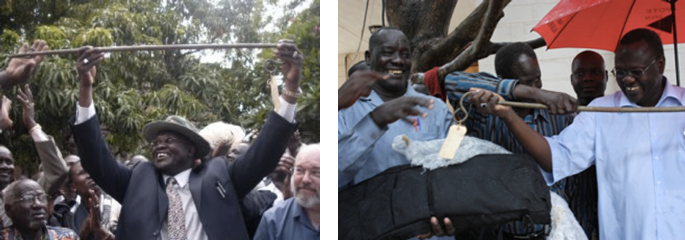
When Kay Coriat died the dang was inherited by her daughter, Honor Baines. I mentioned to her the significance of the dang to the Lou, and she agreed that it should be returned. But by this time the 1983-2005 civil war was in full swing, with the Lou divided among themselves. As much as they needed peace, it was not possible to arrange its return at that time. Honor Baines eventually got tired of waiting and in 1999 she put the dang up for public auction along with photographs and other mementos of her father. Alerted to this auction by a former Operation Lifeline Sudan colleague, Alastair Scott-Villiers, I bought the dang, with the intention of returning it to the Ngundeng family and the Lou Nuer, to join the pipe and drum in Weideang, when circumstances permitted. I kept it locked in a safe in my basement in Oxford for ten years. Mindful that it should not languish on its own without any token of respect, I bought a pouch of Drum tobacco as on offering to Deng to keep it company.
Finally, the Comprehensive Peace Agreement of 2005 and the creation of the Government of South Sudan made the return possible. My former research assistant, Gabriel Gai Riam, had been completing a degree in theology in Edinburgh the year I bought the dang, and I discussed with him what would be the right circumstances for its return. By 2008 he was Minister for Cabinet Affairs in the Jonglei State government and he arranged a meeting in the New Year with Hussein Mar, Deputy Governor of Jonglei State (and also a Lou Nuer). It was at that meeting that we agreed that I should bring the dang with me on my next visit to Juba. I left it with them to arrange how this would be managed with Riek Machar, then Vice-President of the Government of South Sudan.
That was the last I heard of it for the next few months. Then, in April, internet rumours began to circulate about the return of the dang. One report that made it onto the Sudan Tribune website announced that ‘UK authorities’ had agreed to return the dang after incarcerating it in London for eighty years, and that I would be accompanying its return. This gave rise to an enquiry from the Foreign and Commonwealth Office. I managed to make contact with Hussein Mar; and some telephone calls later I finally made contact with Riek Machar. They insisted that there should be a reception for the dang on its arrival at Juba airport. I suggested that it would be a good idea if I had a covering letter to show to any airline or customs official on the way who might question why I was trying to take a long thin, dangerous-looking object onto a plane. I drafted such a letter at Riek’s suggestion and packed the dang into a bag designed for a sniper rifle, the only protection for it I had been able to find. And so, in due course, I arrived in Kenya with a suspicious-looking package and a faint printout of a signed letter from the Vice-President of the Government of South Sudan requesting ‘to whom it may concern’ to give me every assistance in returning this historic relic.
The arrival of the dang in Juba
From Nairobi I flew to Juba, the capital of South Sudan. As we landed there was a small crowd outside the VIP lounge, and official cars with lights flashing and sirens. Some passengers on the plane thought it might be Salva Kiir, the President. In fact it was the former South African President Thabo Mbeki on an AU peace mission. Riek Machar, as Vice- President, was there to greet him, but cut the greeting short. ‘Ah,’ Mbeki was heard to remark, as he was handed on to the GOSS Minister for Cabinet Affairs, ‘the Nuer Cultural Event’.
By the time I descended from the plane a few more pick-up loads of people arrived, unfurling banners praising Ngundeng and welcoming the dang. John Luk, Minister of Energy and Mining, headed an official group to greet me. I suggested that it might be best if we retrieved the dang from the cargo hold of the plane before going ahead with whatever official reception was planned. As we turned around and headed for the side of the plane where the cargo was being unloaded there was a great shout and the crowd of Nuer who had gathered outside the terminal surged around the back of the plane and surrounded the baggage cart, craning their necks to look into the cargo hold. When one of the luggage handlers shoved out a long thin cardboard box there was another cry and ululation as people excitedly began clambering onto the cart.
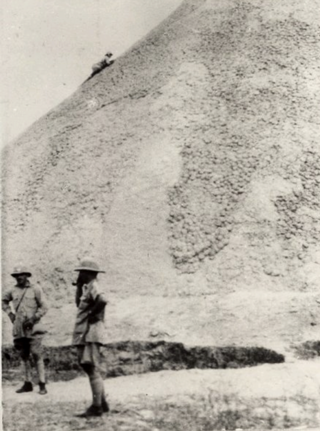
‘That’s not it’, I shouted, but by this time I had been shoved to the back of the crowd. This was to be my frequent vantage point for much of the day. SPLA police struggled to form a cordon around the cart, and someone pushed me to the open cargo hold so that I could retrieve my luggage myself. I found the bag that contained the dang and pulled it out. Soon afterwards the Vice-President appeared, striding through the crowd, in suit and tie, a white ostrich plume pinned to his safari hat, and carrying a short decorative aluminium spear with a blunted point. A little behind him came Gabriel Gai Riam, my former research assistant. I was relieved to see him there. I handed down the sniper bag to the Vice-President and shook hands with Gabriel. Riek raised the bag to yet another great shout and strode off. Someone else followed him holding my suitcase aloft. By the time I had got down from the cart the crowd had cleared the plane and was heading, not for the terminal building, but around it, and for the car park in front. It seemed to me that the crowd was in danger of splitting to follow two similarly coloured, but quite different containers: the sniper bag with the dang, and my suitcase, with my clothes.
I followed, falling further and further behind as people stopped me to shake my hand. ‘Are you Douglas?’ they would ask, and then ‘Thank you!’ I passed Skye Wheeler, then the Reuter’s correspondent, as she was interviewing a young man wearing a cardboard sign proclaiming ‘Ngundeng Bong for Southern Sudan’. There was a scrum of people and cars in the airport car park, some of them regular passengers trying to escape and having a hard time of it with the crowd of Nuer blocking the way. Eventually I was led to where Riek Machar and his wife Angelina, the State Minister for Energy and Mining, stood, next to a sacrificial white ox with spreading horns. The crush of people was such that I was sure someone would get hurt by the thrashing of the ox’s death throes if anyone speared it there. I half wondered if Riek would try to repeat a reputed feat of Ngundeng, who killed an ox by merely shaking the dang at it. Fortunately, he didn’t try, and merely tapped the sacrificial animal symbolically with his blunted aluminium spear. The ox was sacrificed in the airport car park after we left.
I was now in the Sudan illegally, as no one had examined and stamped my passport and travel permit, nor cleared my bags through customs. Riek laughed and said he would take care of that. At the Vice-Presidential palace, a one storey building within a compound still under construction, we sat in the air-conditioned sitting room, with the sniper bag on a table in front of a couch. Two very tall Nuer men wearing civet cat skins sang Ngundeng songs. They seemed intent on singing the whole Ngundeng canon, which would have taken some days, until Riek called a halt. Hussein Mar was still in Jonglei sorting out the peace agreement between the different counties in Jonglei.
As we waited for the crowd to reassemble I watched through the windows small boys carrying cartons of water bottles on their heads for the people outside (the arena would be littered with empty plastic water bottles by the end of the day). We could hear drumming, bugles, and cowbells, as more people arrived. Finally, when enough of a crowd had assembled, and the audio and video equipment were in place, we processed along concrete paths to another part of the compound, a large square which was a waste ground of discarded building material. We were seated in chairs and sofas underneath some shade trees, Riek and Angelina together on a sofa like royalty, with the sniper bag on a coffee table in front of them.
The welcoming ceremony
What followed was neither choreographed nor entirely scripted, but a visible demonstration of the ordered anarchy that the anthropologist Sir E.E. Evans-Pritchard noted as a distinctive feature of Nuer social organisation. Without any religious frenzy, persons and groups performed, according to the Quaker phrase, ‘as the spirit moved them’. During the speeches if someone had the impulse to sing or dance, they did so, and others joined in.
Two dance troupes of young men, dressed in football shorts and jerseys, carrying bamboo sticks and painted pointed metal shields competed with each other, dancing in lines the way the Lou Nuer do, and holding mock spear fights. One group had black shields with ‘Maale’ (the common Nuer greeting) painted in large white letters, along with an anti-AIDS slogan superimposed on an SPLA flag. These were members of the Maale Heritage Development Foundation. Their founder, a young man named Deng Nhial Chiok, was dressed all in white (shirt, trousers and shoes) and had draped a leopard-skin print cloth over his shoulder, in the style of the Nuer kuar muon, the earth-master or leopard-skin chief. He acted as the MC throughout the day.
Various government dignitaries arrived at different times, among them Luka Biong, then Minister for Presidential Affairs, Martin Elia Lomoro, then Minister for Parliamentary Affairs, Gier Chuang Aluong, then Minister for Telecommunications (whose baptism at Juba Cathedral I had attended in 2007), Dr. Joseph Monytuil, then Minister for Health, Michael Mario, who had been Peter Gatkuoth’s secretary when I first did my research, and D.K. Matthews, the oldest elder there. Absent was the President, Salva Kiir, who was in Bentiu, and Albino Akol Akol, then Minister of Culture, Youth and Sports, who was in India. Those who gave speeches frequently had to speak over spontaneous singing, or compete for attention with the impromptu dancers, male and female.
Some Dinka dancers from Aweil and Warrap States arrived unexpectedly, and the proceedings were interrupted as they were identified and announced. The Aweil troupe carried a life-size cardboard figure of a khawaja (the Sudanese Arabic term for a European or American) dressed in an undershirt and tattered shorts, with articulated limbs which they made to dance by jiggling it rhythmically. ‘I think that’s supposed to be you’, laughed Gabriel. A couple of dancers also wore black fringe beards tied around their chins. They danced vigorously, their arms raised to represent horns wide spread, and stamping their feet, one ankle of each being tied with rattles. Riek enjoyed this and got up to face them, stamping his feet, too.
He danced frequently. When he liked a dancer or a singer he got up and waved his hand over their heads. This meant that we all got up and did the same. One group of women came up waving the bamboo sticks and shields they had borrowed from the men, so Angelina took Riek’s aluminium spear and joined them, and Riek soon followed. I could just see the ostrich feather on his hat bobbing above the heads of the women as they surrounded him.
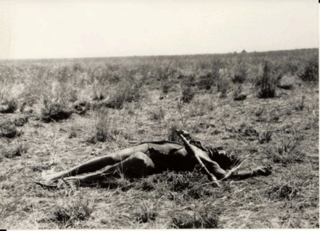
Miss Joy, an elegant young lady in white high heel sandals sang a modern song to East African-style music. The refrain was ‘Ngundeng Highway’ (the proposed name for a proposed highway to Ethiopia). Then Mary Boya, a Murle from Jonglei, sang to similar accompaniment another modern song in Arabic with the English refrain, ‘I’m Crazy for Referendum’. Both songs were enthusiastically received. After the event Mary told Deng Nhial Chiok that later she had a dream that a man was fighting the whole Southern Sudan, and that man was Riek. In her dream she started running, but then a voice told her that those who had been at the reception for the dang were blessed.
There were many speeches, by and large in Nuer, with no translation, though many of the speakers slipped in and out of Nuer, English and Arabic, sometimes within the same sentence. Michael Mario gave a brief history of Ngundeng, some of which was correct. Every nation had its history, he said, and the dang was for the whole of Southern Sudan. Gabriel gave a more accurate account, in Nuer, of the history of the dang, how it had ended up with ‘NyaKurieth’ (Coriat’s daughter), how I had bought it, and how he and Hussein Mar and I had planned to bring it back this year. Martin Lomoro gave a speech in Arabic about how the dang was for all people and for peace in the South. Riek was enthusiastic, ‘That’s exactly the tone we want to strike’ he exclaimed.
Finally it was time to unveil the dang. Riek laid the sniper bag on a table in the arena. Another white ox was brought out. No Nuer had seen the dang for eighty years, said Riek, except for Gabriel and Hussein when they came to see me in Oxford. I unlocked the sniper bag and unwrapped the bubble wrap round the dang, section by section, until it was fully uncovered. Then I handed it to Riek, who raised it in both hands for as many as were able to see.
Amid the excitement there may have been a sense of anti-climax. The bubble wrap and sniper bag made the dang look bulkier than it is. In the end it is only a long stick, wrapped in copper wire, broken at one end. That, of course, is a reasonable proof that it is genuine, as Ngundeng’s dang was broken, and he often referred to his ‘broken dang‘ in his songs. Another proof was the shipping label, in Coriat’s hand, which has been on it ever since Coriat brought it England eighty years ago. Anybody nearby with a digital camera or a mobile phone (and there were a lot of them) began taking pictures of the dang. Those near enough touched it, more out of curiosity than reverence, or came up to take a good look at the label.
The two singers in civet cat skins had been quietly smoking their long pipes during most of the previous proceedings. Removing the pouch of Drum pipe tobacco that had kept the dang company for the last ten years, I called for tap naath (Nuer tobacco). When they understood what I wanted both singers came up eagerly, giving me a pinch of tobacco, and sprinkling some of it on the dang and on the ox.
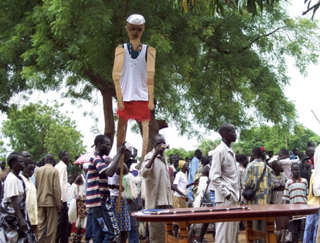
A wider circle was cleared as the ox was moved further away from the table and then pulled down to lie on its right side. They were taking no chances in seeing which way it might fall. Riek had tapped it with his blunt spear, but it was slaughtered in the Muslim way, by slitting its throat with a knife. (I have no idea whether this is a new modification of cattle sacrifice, or whether it was done so on this occasion to enable any Muslims present to share in the meat.)
There was such a hubbub I thought there could be no further speeches, but we still had two to go. The microphone was handed to me. I kept it short, with Gabriel translating, though that didn’t seem to be needed, as there was applause even before the Nuer translations. I said that I was glad to have played some part in bringing the dang closer to home. It wasn’t home yet, but it would be brought back to Waat and Weideang (cheers). The dang now belonged to the Naath (as the Nuer refer to themselves) and to the Janubiyin, the people of South Sudan (more cheers). The dang had been removed in a time of war, but now it was a time of peace. This was the time for peace and reconciliation. Though peace had come there was still fighting in the South and I hoped the dang would play a role in bringing that fighting to an end, building peace and fostering reconciliation (even more cheers).
Riek’s final speech was more nationalistic, claiming that Ngundeng had foretold the emergence of an independent Southern Sudan and the coming referendum. He praised me extravagantly for all the things I had done for the South and promised that when the dang was returned to Weideang I would be invited to come. It was no coincidence, he said, that the dang was returned on the 16th of May, the anniversary of the beginning of the revolution against the north, now National Day in South Sudan. (In fact, it was a coincidence). It was sad, he said, that Kerubino Kwanyin, William Nyuon and John Garang were not alive to witness the event. It struck me that all three of these rebel commanders, leaders of the Sudan Peoples’ Liberation Army in its early days, had ended up trying to kill each other, so it would have been a real test of the dang as an instrument of reconciliation had they all been present.
With the ceremony over, the dang was put back in its sniper bag and placed in Riek’s hands.
‘Its no longer my responsibility’, I said to him, ‘but yours’.
After the ceremony
The dang generates its own stories. ‘Is it true what people are saying,’ Deng Nhial Chiok asked me later, ‘that the family in England who were keeping the dang have had a lot of deaths, and this is why they have now released it?’ Everyone dies in time, I replied, and those in the family who have died did so at an age when it would be expected.
Not everyone was pleased to see the dang brought back in such style. Conspiracy theories were aired: Riek wanted to use the dang to become President of South Sudan, it was said, because Salva Kiir would die if he touched it. In fact Salva also announced the return of the dang in a speech to assembled traditional leaders the day of its arrival, and later in Juba at the delayed SPLA Day celebrations. Some Christians denounced it all as witchcraft and idolatry, though there were Christians there to greet it, most notably my research assistant Gabriel Gai, now the Reverend Gabriel Gai Riam. One member of the Bul Nuer branch of Ngundeng’s family, the office manager of the former militia leader Paulino Matip, complained that Riek had politicised the dang. It should have been given to him instead, he said. But he was silenced by other members of the Ngundeng family.
Due to its association with Ngundeng and his songs and prophecies it is inevitable that the dang should enter the mix of South Sudanese politics. But Nungdeng’s prophecies are notoriously difficult to tame. The first of them that I heard, in 1975, was that there would be two civil wars and the second would be worse, but shorter, than the first. As applied to Sudan’s civil wars this proved to be wide of the mark: the second war was far worse than the first, but also far longer. If the prophecy is now reinterpreted to apply to the two intra-South Sudanese civil wars in which Riek has been involved it is coming closer to fulfilment.
On 16 May 2009, the day that Ngundeng’s dang was returned to Juba, President Salva Kiir Mayardit was in Bentiu addressing a convention of traditional leaders. In his speech to them he made the following announcement and pledge:
I would like also to share with you on this special day that the Dang (Bow) of our Great Spiritual Leader Guet Nyondeng [sic] has been returned back from United Kingdom to Juba on the historic day of the 16th May. The return of this holy artifact Dang (Bow) is a victory to our people as it symbolized the resistance of our people, particularly our traditional leaders…. Although this holy Dang was used for war, we will urge our Nuer traditional leaders to use it for promoting peace and unity among our people…. Maburuk to our traditional leaders for having our holy Dang back home. We will keep it as an important national artifact for our national museum. I direct our Ministry of Sports and Culture to make the necessary arrangements in consultation with Nuer community to preserve this important national artifact.
The dang was considered of sufficient national importance that a second event marking its return was held in Juba that July. This was attended by the President and Vice-President, the cabinet, members of the Southern Legislative Assembly, members of the Jonglei state government, and other dignitaries including former militia leaders—among them a grim and silent Paulino Matip—and Peter Gatdet, who sacrificed an ox on behalf of the Bul Nuer. Simon Mayen Tut, a veterinary dresser I had known in Malakal in the 1970s and who had accompanied me on my first visit to Ngundeng’s Mound, the great edifice of earth that Ngundeng built near Waat, was also there. Now in his eighties, he remembered fleeing into the bush when government soldiers came to fight Guek in the 1920s. Not relying on government assurances that the dang would eventually be returned to Waat, a short distance from the Mound, he said he wanted chance to see the dang once before he died.
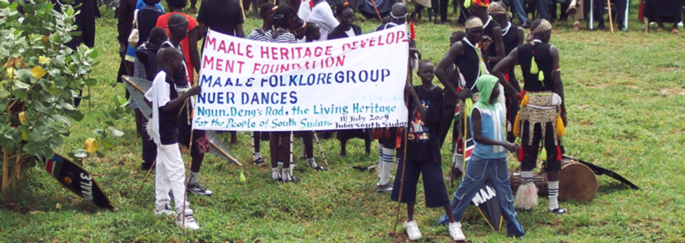
Ngundeng’s prophecies and the role of the dang in current events
The presidential directive was never put into effect. The department of Archives and Antiquities within the ministry remains chronically under-funded and understaffed. There is no museum building in which to keep it, no secure storage for a temporary home, and there are no trained staff to take charge of this, or any other, national treasure. Following the celebrations in Juba the dang remained in the Vice-President’s possession in his compound. On one occasion, when Gabriel Tang Ginya, another Nuer militia leader, was briefly brought back into the fold in 2010, Riek performed a ceremony with the dang where he, Tang Ginya, and Tang Ginya’s subordinates all took hold of it together.4 If this was meant to bind Tang Ginya more firmly to the government or to Riek it failed. It is not known if Riek regularly used the dang in this way with others whose political support he might have been canvassing, but he did use it to appeal to other Nuer opposition leaders prior to the referendum.5 Now, following Riek’s dismissal as Vice-President in July 2013 and his flight from Juba in December, the fate of the dang has taken yet another turn.
Even before these latest events, the fact that the dang was not being returned to its rightful owners, and that Riek seemed to be using it as his own personal property, was deeply upsetting to many Lou Nuer. I received several requests to intervene to get it released. Riek’s response was that there was too much insecurity in Jonglei to return it to the Lou just yet. This argument gained some validity as the conflict between the Lou Nuer and their neighbours, the Murle, escalated in 2012. Now it has been subsumed in the wider conflict in the South ignited in December 2013.
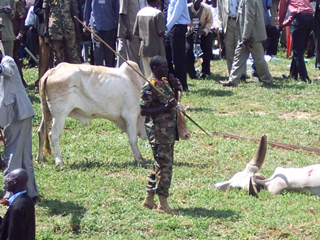
The political symbolism of the dang has been reinforced by Riek’s attempt to harness Ngundeng’s prestige to his own political ambitions. Members of his breakaway movement in the 1990s, which split the Sudan Peoples Liberation Movement, tried to justify their actions by claiming that they were the fulfilment of Ngundeng’s prophecies.6 The failure of that movement notwithstanding, after the signing of the Comprehensive Peace Agreement in 2005 and Riek’s accidental elevation to the vice presidency following Garang’s death, many of Riek’s followers continued to claim that Riek would be the fulfilment of alleged Ngundeng prophecies predicting an independent South Sudan and a Nuer ruler. Such claims can only have been encouraged by Riek’s declaration of rebellion and creation of a new rebel movement in 2014.
There are various elements to this claim. One is that Ngundeng is supposed to have predicted that a left-handed man with a gap in his teeth would rule, and this fits Riek’s physical description. There are also the alleged references in Ngundeng’s songs to his contemporary, the Western Nuer prophet of Teny, from whom Riek claims descent. None of these claims stand up to scrutiny.
Ngundeng was left-handed, a physical trait that was both unusual and considered dangerous. He was also an advocate of peace between the sections of the Lou Nuer and between the Lou and their neighbours, including the Dinka. References to a left-handed man in his songs are usually understood to be references to himself. However, at the end of Sudan’s first civil war in 1972 a new interpretation began to circulate that these references foretold Abel Alier’s successful negotiation of the Addis Ababa Agreement and the peace it brought, as Abel Alier, too, is left-handed.7 Since then other left-handed men have had an impact on Sudan, George W. Bush being one of them, and given his popularity among South Sudanese for his role in supporting the peace negotiations there could be many who would apply Ngundeng’s references to him. President Obama is left-handed too. As far as the reference to a man with a gap in his teeth, there could be many more to which this might apply, given the Nuer practice of removing their lower incisors. In any case I cannot recall any such reference in my own research carried out before the war.
As for the songs, all Nuer prophets composed songs in praise of themselves and their divinities, and they often included gifted composers of songs among their acolytes. I recorded some 318 versions of Ngundeng’s songs in 1975-6. These were collected among the Lou Nuer in Waat and at Ngundeng’s main shrine five miles north of Waat. I cannot say with certainty that I recorded all known Ngundeng songs, since I was unable to make a systematic collection of songs in the Nasir area, where Ngundeng’s most famous songster lived, yet many of the songs I did record were identified as his compositions. Many of these songs mentioned Ngundeng’s divinity, Deng, by name. When any rival prophet was mentioned it was to disparage their claims, to subordinate them to Deng. In none of the songs that I collected was the name Teny, or Teny-Dhurgon, or any of the Western Nuer prophets ever mentioned. Nor is there any mention of Teny in any of the other pre-war collections of Ngundeng’s songs I have been able to consult.
If there is now a song circulating specifically mentioning Teny it is either a recent composition, or it is one of the songs that the prophets of Teny composed about themselves. In either case, it cannot be attributed to Ngundeng. Furthermore, the prophets of Teny might not be the best role models to follow for a modern South Sudanese politician. The first prophet of Teny was killed during a combined Nuer-Dinka attack on the Egyptian outpost at Rumbek in 1883. His successor had some influence among the Western Nuer until most of his cattle died towards the end of the nineteenth century. His twentieth-century successor was even less successful. Accused of sleeping with other men’s wives, he was seized by their irate husbands who cut off his penis.8 Whatever support there might be for applying Ngundeng’s prophecies to Riek, one branch of the Ngundeng family has publicly denounced his claims.9
The fulfilment of prophecy is hard to predict. Invariably it is only after the fact that a prophecy is said to have come true. Using prophecies as a blueprint for the future is always problematic. Take any edition of the prophecies of Nostradamus. The events that his quatrains are said to have predicted are usually clustered within the twentieth century, within our time rather then spread out over a span of centuries. The rise of fascism, the Second World War, the assassination attempt on Pope John Paul II are deemed fit subjects for prophecy, but not, for instance, Henry Ford’s invention of the production line, or the world wide web, or the European Union. Or Google ‘Isaiah chapter 18’.
Woe to the land of whirring wings along the rivers of Cush, which sends envoys by sea in papyrus boats over the water. Go, swift messengers, to a people tall and smooth-skinned, to a people feared far and wide, an aggressive nation of strange speech, whose land is divided by rivers.
Ever since the Good News Bible replaced “Cush” with “Sudan” and added the sub-heading “God will punish Sudan” many South Sudanese and evangelical Christians believe that this verse is about the future of South Sudan, rather than an ancient alliance against the Assyrians. Yet there are still others who are convinced that the prophecy refers not to South Sudan but to a forthcoming (and much desired) war between the USA and Iran. Take your pick.
Ngundeng’s songs will continue to inspire interpretation. The songs are often in obscure language, making references to now forgotten contemporary events that can be reinterpreted to apply to current events. These comparisons are inevitable as long as South Sudan’s present continues to resemble the disturbed and violent times in which Ngundeng lived.
The fate and whereabouts of the dang are as yet unconfirmed. Riek’s actions have politicised it to the extent that it has ceased to be considered a national historic relic. Since the new outbreak of war in South Sudan there have been reports that Riek continues to use the dang as a religious object to solidify a sense of Nuer entitlement and unity behind his own aspirations. If that is the case it should be noted that the last person who attempted to use the dang in an anti-government rebellion, Guek Ngundeng, ended up dead, with his mutilated body on public display.10 If the dang does have any power it can be as dangerous to those who hold it as to those who oppose it. Some fear that should government forces recover the dang it will be destroyed, a casualty of the political struggle between Riek and Salva Kiir. If that happens it will become an even more potent symbol of the fractured hopes of South Sudan.
Notes
1 Douglas H. Johnson, Nuer Prophets (Oxford: Clarendon Press, 1994), p 93.
2 Douglas H. Johnson, ‘The prophet Ngundeng and the battle of Pading’ in David M. Anderson & Douglas H. Johnson (eds), Revealing Prophets (London: James Currey, 1995), pp 196-220.
3 Coriat’s reports on the Nuer, including his account of the death of Guek Ngundeng, have been published in Douglas H. Johnson (ed.), Governing the Nuer: Documents by Percy Coriat on Nuer History and Ethnography 1922-1931 (Oxford: JASO, 1993).
4 See Daniel Bergner, ‘Attention-Grabber for Sudan’s Cause’, New York Times Magazine, 5 December 2010, accessed 29 July 2014.
5 James Gatdet Dak, ‘A Senior Member of NCP Leadership Council visits Juba’, Sudan Tribune, 30 November 2009, accessed 29 July 2014.
6 Johnson, Nuer Prophets, pp 346-8.
7 Johnson, Nuer Prophets, p 317.
8 Johnson, Nuer Prophets, pp 249-50.
9 ‘The Family of Nuer Prophet Ngundeng Congratulates Pagan Amum and his Colleagues for Rejecting Riek Machar’s Rebellion’, 30 May 2014, accessed 7 June 2014.
10 Johnson, Nuer Prophets, p 200.

